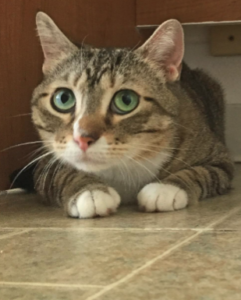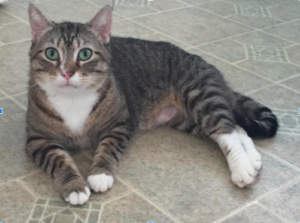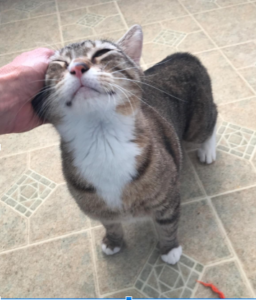Cats in the Basement: Let’s Help Them Venture Forth! (Part 3)
by Cheryl Kolus, DVM, KPA-CTP
In Part 2 of this series, we discussed big-picture strategies to help mitigate your cat’s fear and talked about triggers and reinforcers. We also emphasized the importance of ruling out underlying medical problems and providing hiding places so your cat can feel safe. So now that you’ve done that and you can identify what triggers your cat’s fear and what might reinforce relaxation, we can work on behavior modification. There are several techniques to consider.
Using food
Sometimes simply offering high-value food is enough to relax a cat. However, there are tricks to presenting food. With some, you can offer it in a dish and get slowly closer to the cat while he’s eating, maybe even petting him. With others, you can offer it on a spoon or tongue depressor while not facing him or looking at him directly. Will he eat it while you hold the spoon? Will he eat it if you let go of the spoon? Will he eat it if you put the spoon down and walk away? The answers will tell you where you need to start, if in fact food is the way to Kitty’s heart.
Using play
Some cats might be fearful but can’t resist a feather floating in the wind, a mouse scampering across their field of view, or a snake slithering just out of sight. Try different toys to see if they will engage in play with you, but make sure the toys aren’t scaring them. Stay calm and quiet, don’t look directly at the cat, and consider starting at a distance where they can watch the toy but it’s not intimidating them. If they just can’t stop themselves from playing, use regular playtime to encourage them to come out of their shell. Put their favorite toys away to use only with you, but leave a few others out for them to bat around when you’re not there, too.
Using petting
Some cats might not let on that they melt when petted or brushed, although for others it might be quite obvious. If your fearful cat enjoys petting, use this to build a bond. Just remain calm and quiet (now is not the time to be talking on the phone or yelling at your kids in the other room), and be observant of their body language to make sure they’re truly enjoying the interaction.
Another option is what I call a petting stick. This could be a toothbrush taped to a wooden dowel, (see photo below) or some people use a back scratcher. A petting stick provides a way to touch the cat without getting as close to him, and for some cats, it’s less scary than a hand reaching toward them. First, just lay the petting stick down near the cat for him to investigate it if he wants, even leaving it there for hours or days if needed. Touching the cat with it might require trying different approaches. It can be helpful if the cat is facing away from you and you start petting it around the shoulder or top of the head. Or if the cat is facing sideways to you, try the suggestions mentioned above about petting under “Reduce social conflict…” If you’re also using clicker training (see below), you can start by having the cat target the petting stick. Please note that for some cats, a petting stick makes them more fearful, so be very observant of their body language and abandon the stick if it’s not going well.

Desensitization and counter-conditioning
Desensitization involves presenting the scary stimulus at a low enough intensity (e.g., low volume, far distance) that it doesn’t elicit a negative response, and then gradually increasing intensity while still avoiding a negative response. Counter-conditioning speeds this process along by providing something pleasant in the presence of the scary stimulus.
It’s vital to observe your cat’s body language during this process and go very slowly; in fact, if it’s boring you’re probably doing it right! Here is a video of a shelter cat, Zephyr, who did not like being touched; this is his third or fourth training session. In the video, the trainer is feeding Zephyr baby food from a syringe. At first, while feeding, the trainer’s hand is near Zephyr’s neck but not touching him. Then the trainer starts petting him softly while Zephyr eats. In this case, the food and hand are presented at the same time, then taken away at the same time. The cat’s pupils were dilated (a sign of arousal or fear) the first several times, but he was enthusiastically eating, and by the end of the session the pupils were of normal size.
So if your fearful cat is food-motivated but wary of touch, you might be able to do something similar. If Miss Timid is afraid of your dog, you could work through a similar process with the dog far enough away so that your cat sees him but is still comfortable eating. The gradually, over several days or weeks, feed her closer to the dog (while the dog is preoccupied with something good, too), always being careful that your cat remains comfortably eating.
Clicker training
This involves using a marker—in this case a click sound, but it could also be a word such as “good!” or “yes!”—to tell the cat that the behavior he was doing when he heard the click was desirable and that a reward (typically food) is coming within a second or two. Watch these video tutorials for more information. A training session with a cat fearful of you might go like this: Sit sideways across the room from Kitty and slowly blink at him. If he blinks back, click and toss a treat. (Two cautions here: Make sure the click sound doesn’t elicit fear; if so use a softly spoken word instead. Also make sure a treat that comes hurdling toward him isn’t scary; try tossing it more gently, toward his side instead of his face or letting it land farther away. Or consider a long-handled spoon with a lickable treat.) You could also click/treat every time he makes eye contact, or every time he stretches, breathes deeply or relaxes in any way. As he becomes more confident, you can teach him to target your finger or an object and then move on to other fun tricks, even at a distance if needed (like shaping him to go to a mat). I believe clicker training can be very useful for some fearful cats to teach them that interacting with people is a positive thing. Once they enjoy training, it can also be used in the presence of other scary stimuli (visitors, other pets, etc.).
Negative reinforcement
This means that we’re removing something aversive to the cat to reinforce a behavior. I’m mentioning it here particularly for cats for whom we are the aversive something! It would look like this:
- Sit sideways and far enough away so the cat is comfortable.
- Slowly blink at the cat but look away often.
- Watch for any sign of relaxation.
- When the cat blinks, looks at you or away, stretches a limb out, takes a deep breath, or shows any movement really, click or say “good!” and immediately move out of view for about 10-15 seconds.
- Repeat several times.
- Very gradually (perhaps over several days), move closer and repeat the process until Kitty is willing to let you touch him.
A 2010 Animal Sheltering article (pg. 51) by Angela Rentfro summarizes this procedure for use with shelter cats, and if you’re an IAABC member, there’s a free webinar by Beth Adelman about her experience using this method with a fearfully aggressive foster cat.
Management
Managing the cat’s environment to avoid or mitigate triggers is important, as we said. If the trigger is controllable (like visitors or another pet), you might consider strategies like time-sharing or space-sharing the house. This means using closed doors or baby gates to divide the house in such a way that during some part of the day Kitty gets the run of the house but other times she doesn’t, or that Kitty gets to live upstairs with all sorts of enrichment and social time with preferred people while the dog lives downstairs (also with enrichment and social time). It’s still best to incorporate behavior modification to try to help the situation, but sometimes management is going to play a huge role in keeping Kitty feeling safe, possibly for life. This is okay as long as the cat’s needs are being met and you can honestly say his welfare is not compromised.
Pheromones, supplements and medications
Behavior modification and management can be enhanced by the addition of products formulated to reduce anxiety and promote calm. Some people swear by the use of calming pheromones like Feliway to help a cat feel relaxed. Diets like Royal Canine Calm might be helpful, or calming supplements like Zylkene or Anxitane and others can be added to the cat’s food or given as a treat. These are usually quite safe and might help especially in cases of mild fears. But in more serious cases, please don’t be afraid of trying an anti-anxiety pharmaceutical. Although considered “off-label” for use in cats (meaning safety and efficacy have not been comprehensively established for this use in felines), there are published studies of many medications’ use in cats. These meds typically have few side effects and are much more effective than supplements. In my opinion, it’s time to consider pharmaceuticals if the cat’s quality of life is poor, she is harming herself or others, you can’t get far enough away from the cat for her to relax so you can start behavior modification, the fearfulness has been going on for more than a few months or it’s getting progressively worse, and/or the environment or management is not likely to change. The point of medications is to lower the cat’s level of fear and anxiety to a place where she can learn different coping strategies, so behavior modification is still going to be important. While some cats might need life-long meds, many can be eventually weaned off them. A veterinarian with an interest in behavior is a critical piece of the puzzle here to set your cat up for success. It’s also important to find a low-stress method of getting the medication into your cat; pilling a fearful cat isn’t going to help anyone. Many cats will eat crushed pills or powder from capsules mixed with canned food or baby food; sometimes warming the food before adding the pill can entice the cat to eat it. Or you may need to get more creative and hide the med in cream cheese, whipped cream, liverwurst, anchovy paste, etc. Flavored compounded medications might be possible too.
Rehoming and euthanasia
Although most of us hate the idea of giving up on a pet, sometimes it’s truly the right thing to do and is in the pet’s best interest. If behavior modification (with or without medications) isn’t helping and the fear-inducing stimulus is unmanageable or always present, consider rehoming. If you are unable or unwilling to implement the above recommendations or those from a qualified behavior consultant, consider rehoming. If it’s unsafe for the cat to be in your home, or if it’s unsafe for other household members (people or pets) to have the cat living there, please rehome. If we’re talking about a feral cat who would simply prefer an outdoor life, consider rehoming to a relatively safe working home, such as a barn or warehouse. Many fearful cats can thrive under different living arrangements, and don’t assume nobody wants them. Having worked or volunteered in the animal sheltering field for more than a decade, I’ve seen what appears to be the least adoptable animals find good homes. If you’re in an area that has a good animal shelter with knowledgeable behavior staff, get on their waiting list (if a limited-admissions shelter) now or inquire about surrendering your cat. But even better, find him another home yourself to avoid the shelter system, which of course is a tough environment for fearful cats. Best Friends has a great resource for rehoming pets.
Even worse is having to consider euthanasia, but there are times when this might be the best option. If the cat has medical issues along with extreme fearfulness, if it’s truly a danger to people and a working home is not an option, or if rehoming is simply not going to happen for some other reason but her quality of life is poor, then euthanasia might be the kindest thing, and a discussion with your veterinarian might be in order.
Happy endings
But I don’t want to leave you on a down note! Instead, take a look at these pictures of Craisin’s progression. Craisin was a 4-year-old cat in the shelter where I work. A well-meaning woman had taken in Craisin’s pregnant mother and raised the mom and kittens in her shed (and later a room in her basement) because her dog did not like cats. Although the woman interacted with the cats when feeding and cleaning their room, they didn’t get much other socialization. Two of these kittens (now adults) came to our shelter. One appeared behaviorally healthy and got adopted quickly; Craisin was very fearful. But after four months (10 weeks before we could pet her) of patience, kindness, strategic use of food, clicker training and anti-anxiety medications, she came around. She would still run away if approached but would often come up to us for petting. But guess what? She found the best home with a wonderful couple where she is spoiled and loved and is friends with the other cat and even the dog!

Craisin when she first arrived at the shelter.

After several weeks, Craisin started to venture out of her cage but was still wary.

Craisin lying relaxed in the middle of the room at the shelter.

Craisin was clicker trained to do several tricks.

Craisin started to come up to us for petting.

Craisin relaxed and happy in her new home.







